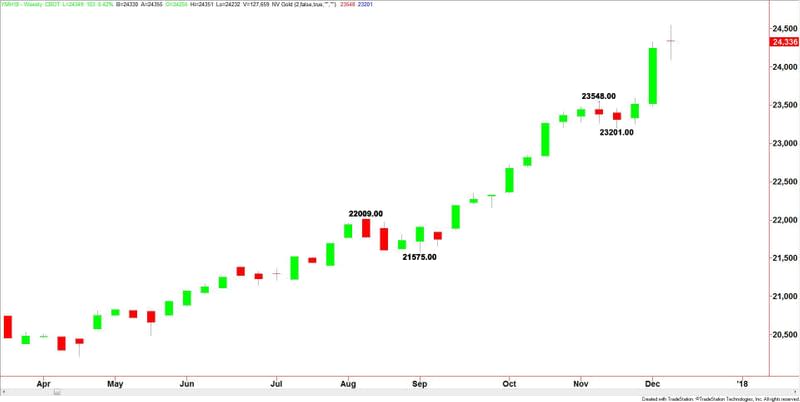S&P 500; US Indexes Fundamental Weekly Forecast – Investors Keying on Tax Reform, Consumer Inflation Data
The major U.S. stock indexes closed mixed last week with the Dow and S&P 500 posting marginal gains and the NASDAQ closing lower. The main influence on the stock market was the potential impact of tax form and other political issues in Washington.
For the week, the blue chip Dow Jones Industrial Average settled at 24,329.16, up 0.4%. Year-to-date, it’s up 23.1%. The benchmark S&P 500 Index closed at 2,651.50, up 0.4%. It’s up 18.4% in 2018. The tech-based NASDAQ Composite ended the week at 6,837.65, down 0.1%. It has gained 27.1 so far this year.

Throughout the week, stock prices swung in both directions with traders responding to news about tax reform and a possible government shutdown. Investor sentiment eventually settled and prices rose into the end of the week. The catalyst behind the rally was optimism over the progress towards U.S. tax reform. With Senate and House Republicans working out their differences, traders anticipate the new tax bill will be delivered to President Trump for his signature before Christmas.
Last Thursday, the Senate passed a stop-gap spending measure to continue funding the federal government through December 22. The bill prevents a shut-down that would have been triggered if Congress failed to pass a spending bill before midnight Friday.

With the two-week spending bill signed, lawmakers will now move on to the far more contentious task of passing a longer-term spending bill before December 22, when Thursday’s bill expires.
Stocks rallied on Friday after government data showed the economy created more jobs than expected in November. While the selling was mostly driven by the headline number, losses may have been limited by average hourly earnings data that analysts said were disappointing.
U.S. Non-Farm Payrolls rose by 228,000 in November. Economists had forecast payrolls rising by 198,000. Average Hourly Earnings rose five cents or 0.2 percent in November, but economists expected a 0.3 percent rise. The annual increase in wages was also weaker than forecast: the November figure came in at 2.5 percent versus a 2.7 percent expectation. The unemployment rate was unchanged at 4.1%.
The lack of wage pressure should not derail the Fed’s plans to raise rates this week, but it will certainly be a key topic of discussion as the central bank grapples with sluggish wages that reflect persistently low inflation.

Forecast
This week, investors will get the opportunity to react to U.S. inflation data, retail sales and a Fed meeting.
Consumer inflation is expected to show a monthly rise of 0.4%, up from 0.1%. This number won’t affect the Fed’s December interest rate decision, but it could have an influence on the number of rate hikes in 2018.
On Wednesday, the U.S. Federal Reserve is expected to raise its benchmark interest rate 0.25% to 1.50%. This has been priced into the market for at least a month. Stocks could surge if the FOMC members express concerns over the number of rate hikes in 2018. A lower than expected CPI number could cause a few members to cut their forecasts from three rate hikes down to two.
Core Retail Sales are expected to up 0.7% from 0.1%. Retail Sales could rise 0.3%, up from 0.2%.
This article was originally posted on FX Empire

 Yahoo Finance
Yahoo Finance 